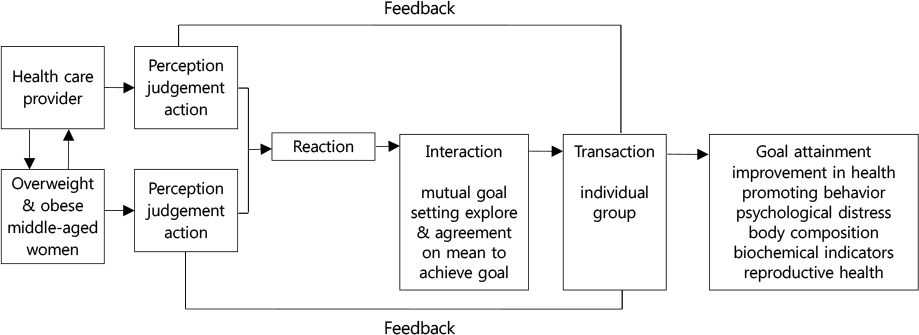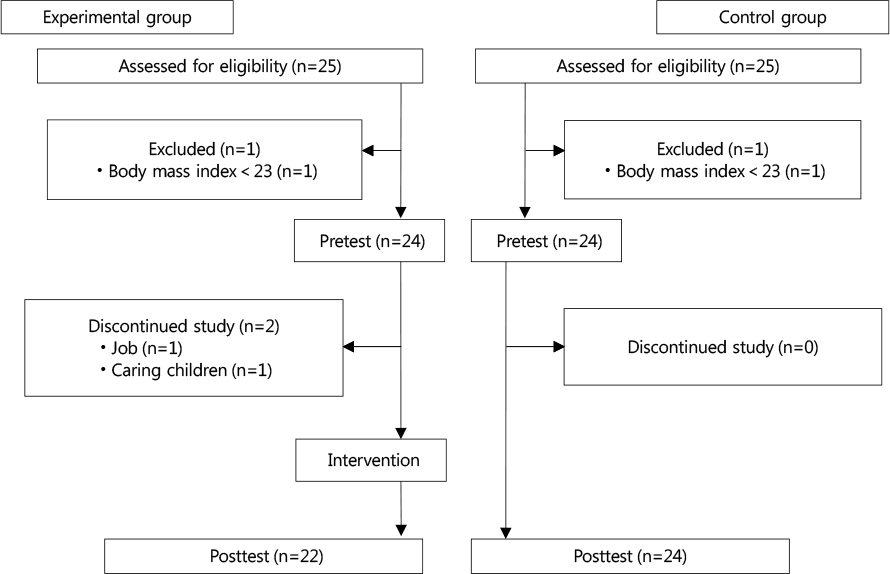Korean J Adult Nurs.
2019 Dec;31(6):663-676. 10.7475/kjan.2019.31.6.663.
Effects of Multidisciplinary Lifestyle Modification Program on Health-promoting Behavior, Psychological Distress, Body Composition and Reproductive Symptoms among Overweight and Obese Middle-aged Women
- Affiliations
-
- 1Associate Professor, College of Nursing, Jeonbuk National University, Jeonju, Korea. jhnho@jbnu.ac.kr
- 2Assistant Professor, Kunsan College of Nursing, Gunsan, Korea.
- KMID: 2466232
- DOI: http://doi.org/10.7475/kjan.2019.31.6.663
Abstract
- PURPOSE
This study aimed to examine the effect of multidisciplinary lifestyle modification program in overweight or obese middle-aged women.
METHODS
This study was conducted from January 2 to June 5, 2018 at Jeonju city in South Korea. A non-equivalent control group quasi-experimental design was used. A total of 46 women were assigned to the experiment group (n=22) or the control group (n=24). The multidisciplinary lifestyle modification program for this study consisted of physical activity, nutritional management, stress management, health counseling, lifestyle monitoring, and affective support based on King's goal attainment theory, which was implemented for eight weeks.
RESULTS
Significant group differences were found in health- promoting behavior (p<.001), depression (p<.001), anxiety (p=.018), stress (p=.001), weight loss (p=.002) and reproductive symptoms (p=.020) among over-weight and obese middle-aged women.
CONCLUSION
Multidisciplinary lifestyle modification program is effective in improving health-promoting behavior, depression, anxiety, stress, weight loss and reproductive symptoms. Therefore, healthcare providers should develop strategies to expand and provide multidisciplinary lifestyle modification program through interaction and transaction for overweight or obese middle-aged women.
MeSH Terms
Figure
Cited by 2 articles
-
Factors affecting unmet healthcare needs of low-income overweight and obese women in Korea: analysis of the Korean National Health and Nutrition Examination Survey 2017
Ju-Hee Nho, Sook Kyoung Park
Korean J Women Health Nurs. 2021;27(2):93-103. doi: 10.4069/kjwhn.2021.05.06.The development of a lifestyle modification mobile application, “Health for You” for overweight and obese breast cancer survivors in Korea
Su-Jin Seo, Ju-Hee Nho, Youngsam Park
Korean J Women Health Nurs. 2021;27(3):243-255. doi: 10.4069/kjwhn.2021.09.14.
Reference
-
1. World Health Organization. Obesity and Overweight [Internet]. Geneva: World Health Organization (WHO);2019. cited 2019 July 23. Available from: https://www.who.int/en/news-room/fact-sheets/detail/obesity-and-overweight.2. Kim I, Bahk J, Kim YY, Lee J, Kang HY, Lee J, et al. Prevalence of overweight and income gaps in 245 districts of Korea: comparison using the National Health Screening Database and the Community Health Survey, 2009-14. Journal of Korean Medical Science. 2018; 33(1):e3. DOI: 10.3346/jkms.2018.33.e3.
Article3. Egger G, Binns A, Rössner S, Sagner M. Lifestyle medicine: lifestyle, the environment, and preventive medicine in health and disease. 3rd ed. London: Elsevier;2017. p. 105–132.4. Simon GE, Ludman EJ, Linde JA, Operskalski BH, Ichikawa L, Rhode P, et al. Association between obesity and depression in middle-aged women. General Hospital Psychiatry. 2008; 30(1):32–39. DOI: 10.1016/j.genhosppsych.2007.09.001.
Article5. Arroyo KJ, Ramos-Torres G, Mezones-Holguin E, Blümel JE, Barón G, Bencosme A, et al. Association between waist-to-height ratio and anxiety in middle-aged women: a secondary analysis of a cross-sectional multicenter Latin American study. Menopause. 2018; 25(8):904–911. DOI: 10.1097/GME.0000000000001089.
Article6. Douchi T, Kuwahata R, Yamamoto S, Oki T, Yamasaki H, Nagata Y. Relationship of upper body obesity to menstrual disorders. Acta Obstetricia et Gynecologica Scandinavica. 2002; 81(2):147–150. DOI: 10.1034/j.1600-0412.2002.810210.x.
Article7. Yang Y, He Y, Zeng Q, Li S. Association of body size and body fat distribution with uterine fibroids among Chinese women. Journal of Women's Health. 2014; 23(7):619–626. DOI: 10.1089/jwh.2013.4690.
Article8. Allison DB, Downey M, Atkinson RL, Billington CJ, Bray GA, Eckel RH, et al. Obesity as a disease: a white paper on evidence and arguments commissioned by the Council of the Obesity Society. Obesity. 2008; 16(6):1161–1177. DOI: 10.1038/oby.2008.231.9. Pender NJ. Health promotion in nursing practice. 3rd ed. Stamford: Appleton & Lange;1996. p. 51–75.10. Kwon S, Mohammad J, Samuel I. Physical activity patterns in morbidly obese and normal-weight women. American Journal of Health Behavior. 2011; 35(2):155–161. DOI: 10.5993/AJHB.35.2.3.
Article11. Muga MA, Owili PO, Hsu C-Y, Rau H-H, Chao JC-J. Dietary patterns, gender, and weight status among middle-aged and older adults in Taiwan: a cross-sectional study. BMC Geriatrics. 2017; 17:268. DOI: 10.1186/s12877-017-0664-4.
Article12. Doyle C, Kushi LH, Byers T, Courneya KS, Denmark-Wahnefried W, Grant B, et al. Nutrition and physical activity during and after cancer treatment: an American Cancer Society guide for informed choices. CA: A Cancer Journal for Clinicians. 2006; 56(6):323–353. DOI: 10.3322/canjclin.56.6.323.
Article13. Moran LJ, Hutchison SK, Norman RJ, Teede HJ. Lifestyle changes in women with polycystic ovary syndrome. Cochrane Database of Systematic Reviews. 2011; 6(7):CD007506. DOI: 10.1002/14651858.CD007506.pub2.
Article14. Baillot A, Romain AJ, Boisvert-Vigneault K, Audet M, Baillargeon JP, Dionne IJ, et al. Effects of lifestyle interventions that include a physical component in class II and III obese individuals: a systematic review and meta analysis. PLoS One. 2015; 10:e0119017. DOI: 10.1371/journal.pone.0119017.15. Thomson RL, Buckley JD, Lim SS, Noakes M, Cliton PM, Norman RJ, et al. Lifestyle management improves quality of life and depression in overweight and obese women with polycystic ovary syndrome. Fertility and Sterility. 2010; 94(5):1812–1816. DOI: 10.1016/j.fertnstert.2009.11.001.
Article16. Haqq L, McFarlane J, Dieberg G, Smart N. Effect of lifestyle intervention on the reproductive endocrine profile in women with polycystic ovarian syndrome: a systematic review and meta-analysis. Endocrine Connections. 2014; 3(1):36–46. DOI: 10.1530/EC-14-0010.
Article17. van Dammen L, Wekker V, Rooij SR, Groen H, Hoek A, Roseboom TJ. A systematic review and meta-analysis of lifestyle interventions in women of reproductive age with overweight or obesity: the effects of symptoms of depression and anxiety. Obesity Reviews. 2018; 19(12):1679–1687. DOI: 10.1111/obr.12752.18. King IM. A theory for nursing: systems, concepts, process. New York, NY: Wiley;1981.19. Walker S, Sechrist KR, Pender NJ. The health-promoting lifestyle profile: development and psychometric characteristics. Nursing Research. 1987; 36(2):76–81.20. Noh JW, Yun HY, Park H, Yu SE. A study of predictive factors affecting health: promoting behaviors of North Korean adolescent refugees. Journal of Preventive Medicine & Public Health. 2015; 48(5):231–238. DOI: 10.3961/jpmph.14.045.
Article21. Henry JD, Crawford JR. The short-form version of the Depression Anxiety Stress Scales (DASS-21): construct validity and normative data in a large non-clinical sample. The British Journal of Clinical Psychology. 2005; 44:227–239.
Article22. Cha ES. Cha Korean translation of the DASS21 [Internet]. Sydney: DASS;2018. cited 2018 January 1. Available from: http://www2.psy.unsw.edu.au/dass/Korean/Korean%20Cha.htm.23. World Health Organization. Sexual and Reproductive Health [Internet]. Geneva: World Health Organization (WHO);2018. cited January 1, 2018. Available from: http://www.who.int/reproductivehealth/topics/en/.24. Imayama I, Alfano CM, Kong A, Foster-Schubert KE, Bain CE, Ciao L, et al. Dietary weight loss and exercise interventions effects on quality of life in overweight/obese postmenopausal women: a randomized controlled trial. International of Behavioral Nutrition and Physical Activity. 2011; 8:118. DOI: 10.1186/1479-5868-8-118.
Article25. Nazari M, Farmani S, Kaveh MH, Ghaem H. The effectiveness of lifestyle educational program in health promoting behaviors and menopausal symptoms in 45-60-year-old women in Marvdasht, Iran. Global Journal of Health Science. 2016; 8(10):55414. DOI: 10.5539/gjhs.v8n10p34.
Article26. Anderson D, Seib C, McGuire A, Porter-Steele J. Decreasing menopausal symptoms in women undertaking a web-based multi-modal lifestyle intervention: the women's wellness program. Maturitas. 2015; 81(1):69–75. DOI: 10.1016/j.maturitas.2015.02.263.
Article27. Kim MK, Lee WY, Kang JH, Kang JH, Kim BT, Kim SM, et al. Clinical practice guidelines for overweight and obesity in Korea. Endocrinology and Metabolism. 2014; 29(4):405–509. DOI: 10.3803/EnM.2014.29.4.405.28. Xenaki N, Bacopoulou F, Kokkinos A, Nicolaides NC, Chrousos GP, Darviri C. Impact of a stress management program on weight loss, mental health and lifestyle in adults with obesity: a randomized controlled trial. Journal of Molecular Biochemistry. 2018; 7(2):78–84.29. Chu SH, Choi EJ, Jekal Y. Analysis of physical activity among Korean middle-aged women: proportionate probability sampling. Journal of Korea Society for Wellness. 2018; 13(1):461–468.30. Haskell WL, Lee IM, Pate RR, Powell KE, Blair SN, Franklin BA, et al. Physical activity and public health: updated recommendation for adults from the American College of Sports Medicine and the American Heart Association. Medicine & Science in Sports & Exercise. 2017; 39(8):1423–1434. DOI: 10.1249/mss.0b013e3180616b27.31. Kim KH, Kim HS, Park KS. The effects of family function, self-esteem, and loneliness on subjective health status in middle-aged women. Korean Journal of Adult Nursing. 2005; 17(2):200–207.32. Cramer SR, Nieman DC, Lee JW. The effects of moderate exercise training on psychological well-being and mood state in women. Journal of Psychosomatic Research. 1991; 35(4-5):437–449.
Article33. Fabricatore AN, Wadden TA, Higginbotham AJ, Faulconbridge LF, Nguyen AM, Heymsfield SB, et al. Intentional weight loss and changes in symptoms of depression: a systematic review and meta-analysis. International Journal of Obesity. 2011; 35(11):1363–1376. DOI: 10.1038/ijo.2011.2.
Article34. Nho JH, Yoo SH. Relationships among lifestyle, depression, anxiety, and reproductive health in female university student. Korean Journal of Women Health Nursing. 2018; 24(1):80–89. DOI: 10.4069/kjwhn.2018.24.1.80.35. Fukuda K. Somatization disorder and bradykinin. Psychiatry and Clinical Neurosciences. 2003; 57(6):609.
Article
- Full Text Links
- Actions
-
Cited
- CITED
-
- Close
- Share
- Similar articles
-
- Effects of the Weight Management Program Based Self-Efficacy for Body Composition, Blood Lipid Profile, Weight Self-Efficacy Lifestyles, Depression in Middle-Aged Obese Women
- A Study on the Relationship among Climacteric Symptoms, Knowledge of Menopause and Health Promoting Behavior in Middle-Aged Women
- A Study on the Relation of BMI to Lipid Metabolism and Health Promoting Behavior in Middle-Aged Women
- Effects of Health Management Program on Body composition, Self-efficacy and Health Promotion Behavior in Middle-Aged Women
- Effects of a Health Promoting Education Program on Self-Efficacy, Knowledge of Health Management and Health Promoting Behavior for Middle-Aged Women



